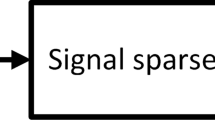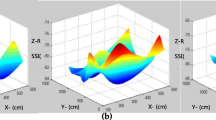Abstract
Presented is a novel compressive sensing (CS) based indoor positioning approach, which uses the signal strength differentials (SSDs) as location fingerprints (LFs). By using certain kernel-based transformation basis, the 2-D target location is represented as an unknown sparse location vector in the discrete spatial domain. Then it just takes a little number of online noisy SSD measurements for the exact recovery of the sparse location vector by solving an ℓ1-minimization program. In order to effectively apply CS theory for high precision indoor positioning, we further import some data pre-processing algorithms in the LF space. Firstly, to mitigate the influence of large measurements noise on the recovery accuracy, a LF space denosing algorithm is designed to discriminate the unequal localization contribution rate of every SSD measurement in each LF. The basic idea of the denosing algorithm is to transform the original LF space into a robust and decorrelated LF space. Moreover, in order to lower the high computational complexity of the CS recovery algorithm, several LF space filtering algorithms are also exploited to remove certain percentage of useless LFs in the radio map according to the real-time RSS observations. The performance of these denosing and filtering algorithms are investigated and compared in real-world WLAN experiment test. Both experimental results and simulations demonstrate that we achieve remarkable improvements on the positioning performance of the CS based localization by using the proposed algorithms.












Similar content being viewed by others
References
Y. Y. Gu, A. Lo, and I. Niemegeers, A survey of indoor positioning systems for wireless personal networks, IEEE Communications Surveys and Tutorials, Vol. 11, No. 1, pp. 13–32, 2009.
G. Sun, W. G. J. Chen, and K. R. Liu, Signal processing techniques in network-aided positioning: a survey of state-ofthe- art positioning designs, IEEE Signal Processing Magazine, Vol. 22, No. 4, pp. 12–23, 2005.
K. Kaemarungsi and P. Krishnamurthy, Modeling of indoor positioning systems based on location fingerprinting, IEEE INFOCOM Proceedings, Vol. 2, pp. 1012–1022, 2004.
S. H. Fang, T. N. Lin, and K. C. Lee, A novel algorithm for multipath fingerprinting in indoor WLAN environments, IEEE Transactions on Wireless Communication, Vol. 7, No. 9, pp. 3579–3588, 2008.
P. Pivato, L. Palopoli, and D. Petri, Accuracy of RSS-based centroid localization algorithms in an indoor environment, IEEE Transactions on Instrumentation and Measurement, Vol. 60, pp. 1–10, 2011.
H. Liu, H. Darabi, and P. Banerjee, Survey of wireless indoor positioning techniques and systems, IEEE Transactions on System, Man and Cybernetics, Vol. 37, No. 6, pp. 1067–1080, 2007.
F. Chen, V. Shahrokh, and T. Zhenhui, Multiple target localization using compressive sensing, IEEE Global Telecommunications Conference, pp. 1–6, 2009.
F. Chen, V. Shahrokh, and T. Zhenhui, Localization of wireless sensors using compressive sensing for manifold learning, IEEE 20th PIMRC Symposium, 2009.
B. Zhang, X. Cheng, N. Zhang, Y. Cui, Y. Li, and Q. Liang, Sparse target counting and localization in sensor networks based on compressive sensing, IEEE INFOCOM Proceedings, pp. 2255–2263, 2011.
F. Chen, V. Shahrokh, and T. Zhenhui, Compressive sensing based positioning using RSS of WLAN access point, IEEE INFOCOM Proceedings, pp. 1–9, 2010.
A. O. Nasif and B. L. Mark, Measurement clustering criteria for localization of multiple transmitters, Proceedings of Conference on Information Systems and Sciences, Baltimore, pp. 341–345, 2009.
J. Haupt and R. Nowak, Signal reconstruction from noisy random projections, IEEE Transactions on Information Theory, Vol. 52, No. 9, pp. 4036–4048, 2006.
A. Hossain, H. Van, and Y. Jin, Indoor localization using multiple wireless technologies, Mobile Adhoc and Sensor Systems (MASS), 2007.
N. Chang, R. Rashidzadeh, and M. Ahmadi, Robust indoor positioning using differential wifi access points, IEEE Transactions on Consumer Electronics, Vol. 56, No. 3, pp. 1860–1867, 2010.
B. Li, Y. Wang, H. Lee, A. Dempster, and C. Rizos, Method for yielding a database of location fingerprints in WLAN, IEEE Communications Proceedings, Vol. 152, No. 5, pp. 580–586, 2005.
D. Donoho, Compressed sensing, IEEE Transactions on Information Theory, Vol. 52, No. 4, pp. 1289–1306, 2006.
R. Baraniuk, Compressive sensing, IEEE Signal Processing Magazine, Vol. 24, No. 4, pp. 118–121, 2007.
J. A. Tropp and A. C. Gilbert, Signal recovery from random measurements via orthogonal matching pursuit, IEEE Transactions on Information Theory, Vol. 53, No.12, pp. 4655–4666, 2007.
S. Chen and D. Donoho, Basis pursuit, Conference Record of the Twenty-Eighth Asilomar Conference on Signals, Systems and Computers, Vol. 1, pp. 41–44, 1994.
J. Deng, Q. Cui, and X. Zhang, Compressive sensing based indoor localization with denosing and filtering in LF space, IEEE 23th PIMRC Symposium, 2012.
R. Battiti, M. Brunato, and A. Villani, Statistical learning theory for location fingerprinting in wireless LANs, Technical Report DIT-020086, Dipt. Informatica e Telecomunicazioni, Univ. of Trento, 2002.
D. Felix, E. Hyun, M. McGuire, and M. Sima, Denoising by Spatial Domain Averaging for Wireless Local Area Network Terminal Localization, International Conference on Communications, Control and Signal Processing ICCCSP, Paris, France, 2010.
M. Youssef, A. Agrawala, and A. U. Shankar, WLAN location determination via clustering and probability distributions, Pervasive Computing and Communications, pp. 143–150, 2003.
Y. Chen, J. Yin, X. Chai, and Q. Yang, Power-efficient accesspoint selection for indoor location estimation, IEEE Transactions on Knowledge and Data Engineering, Vol. 18, No. 7, pp. 877–888, 2006.
S.-H. Fang and T.-N. Lin, Accurate Indoor Location Estimation by Incorporating the Importance of Access Points in Wireless Local Area Networks, 2010 IEEE Global Telecommunications Conference (GLOBECOM 2010), pp. 1–5, 2010.
K. Kaemarungsi and P. Krishnamurthy, Properties of Indoor Received Signal Strength for WLAN Location Fingerprinting, First Annual International Mobile and Ubiquitous Systems Conference, pp. 14–23, 2004.
B. Richard, D. Mark, D. Ronald, and W. Michael, A simple proof of the restricted isometry property for random matrices, Consructive Approximation, Vol. 28, No. 3, pp. 253–263, 2008.
M. Loog, R. P. W. Duin, and R. Haeb-Umbach, Multiclass linear dimension reduction by weighted pairwise Fisher criteria, IEEE Transaction on Pattern Analysis and Machine Intelligence, Vol. 23, No. 7, pp. 762–766, 2001.
G. I. Wassi, C. Despins, and C. Nerguizian, Indoor location using received signal strength of IEEE 802.11b access point, IEEE Electrical and Computer Engineering Conference, pp. 1367–1370, 2005.
A. Kushki, K. N. Plataniotis, and A. N. Venetsanopoulos, Kernel-based positioning in wireless local area networks, IEEE Transaction on Mobile Computing, Vol. 6, No. 6, pp. 689–705, 2007.
Acknowledgment
The work was supported by the National Nature Science Foundation of China Project Grant No. 61001119, Beijing Nova program (No. xx2012037) and Program for New Century Excellent Talents in University (NCET 12-0795).
Author information
Authors and Affiliations
Corresponding author
Rights and permissions
About this article
Cite this article
Deng, J., Cui, Q. & Zhang, X. Data Pre-Processing in Compressive Sensing Based Indoor Fingerprinting Positioning. Int J Wireless Inf Networks 20, 256–267 (2013). https://doi.org/10.1007/s10776-013-0226-4
Received:
Accepted:
Published:
Issue Date:
DOI: https://doi.org/10.1007/s10776-013-0226-4




